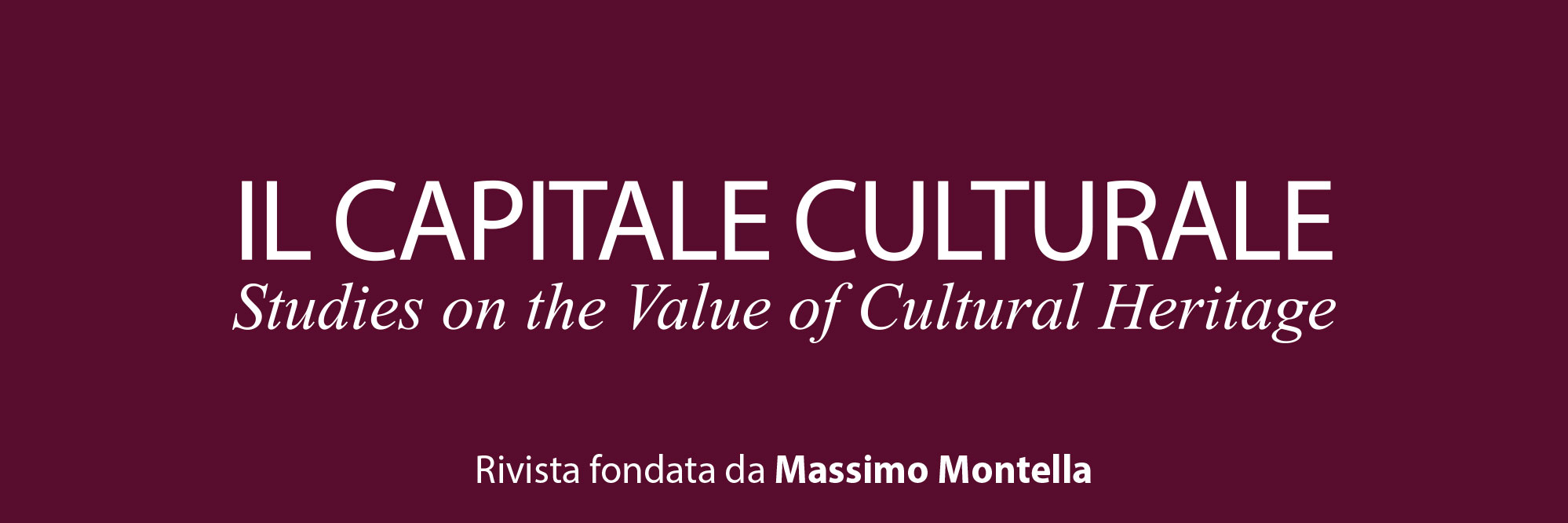Managing visitors' flows in museums. The case of Firenze Card
Downloads
Pubblicato
Fascicolo
Sezione
Licenza
Tutti i materiali pubblicati sono coperti da copyright, mantenuto dall'Università di Macerata che ne supporta finanziariamente e tecnicamente la pubblicazione.
La licenza adottata è la Creative Commons - Attribuzione/Condividi allo stesso modo. Ovvero, gli autori che pubblicano su questa rivista accettano le seguenti condizioni:
- Gli autori mantengono i diritti sulla loro opera e cedono alla rivista il diritto di prima pubblicazione dell'opera, contemporaneamente licenziata sotto una Licenza Creative Commons - Attribuzione che permette ad altri di condividere l'opera indicando la paternità intellettuale e la prima pubblicazione su questa rivista.
- Gli autori possono aderire ad altri accordi di licenza non esclusiva per la distribuzione della versione dell'opera pubblicata (es. depositarla in un archivio istituzionale o pubblicarla in una monografia), a patto di indicare che la prima pubblicazione è avvenuta su questa rivista.
- Gli autori possono diffondere la loro opera online (es. in repository istituzionali o nel loro sito web) prima e durante il processo di submission, poiché può portare a scambi produttivi e aumentare le citazioni dell'opera pubblicata.
DOI:
https://doi.org/10.13138/2039-2362/2379Abstract
This article aims to enlarge the study of new technologies for monitoring visitors’ flows in cities of art. Based on data collected thanks to the use of the Firenze Card by city visitors, the article investigates the museums co-visits networks in Florence for understanding the visitors’ flows within the city, identifying the great attractors, the networks of minor museums, which museums receive or send more visitors to others. The analysis highlights the potential that such a study can develop in the future for optimizing the management of tourist flows and improving the local cultural offer. The novelty of the dataset together with interesting results allows us to provide the policymakers with useful information about the principal nodes of attraction of tourists, which can be used to improve the cultural services, also through the suggestion of alternative paths.
Questo articolo si propone di ampliare lo studio delle nuove tecnologie per il monitoraggio dei flussi dei visitatori nelle città d’arte. Sulla base dei dati raccolti tramite l’utilizzo della Firenze Card da parte dei visitatori della città, l’articolo vuole analizzare le reti di co-visita dei musei di Firenze per comprendere i flussi dei visitatori, identificare i grandi attrattori, le reti dei musei minori e quali musei “ricevono/inviano” più visitatori rispetto agli altri. L’analisi evidenzia il contributo che studi di questo tipo possono apportare all’ottimizzazione della gestione dei flussi turistici, al fine di migliorare l’offerta culturale locale. La novità dei dati utilizzati e i risultati evidenziati dall’analisi contribuiscono a fornire ai policymakers informazioni utili sui principali nodi di attrazione turistica, cruciali per migliorare i servizi culturali, anche attraverso la proposta di percorsi alternativi.
Riferimenti bibliografici
Bacci S., Bertaccini B., Dinelli R., Giusti A., Petrucci A. (2019a), A network analysis of museum preferences: the Firenzecard experience, in Smart Statistics for Smart Applications, Book of Short Papers SIS 2019 (Milan, Italy, June 18-21, 2019), edited by G. Arbia, S. Peluso, A. Pini, G. Rivellini, Torino: Pearson, pp. 653-658, https://it.pearson.com/content/dam/region-core/italy/pearson-italy/pdf/Dirigenti%20e%20istituzioni/ISTITUZIONI-HE-PDF-sis2019_V4.pdf, 3.08.2020.
Bacci S., Bertaccini B., Petrucci A. (2019b), Museum preferences analysis: an item response model applied to network data, in Statistics for Health and Well-being, Book of Short Papers of the ASA Conference 2019 (Brescia, Italy, September 25-27, 2019), edited by M. Carpita, L. Fabbris, Brescia: CLEUP, pp. 21-24.
Baggio J.A., Baggio R. (2020), Modelling and Simulations for Tourism and Hospitality: An Introduction, Bristol: Channel View Publications, https://doi.org/10.21832/9781845417437.
Bellini N., Campostrini S., Pasquinelli C., Trunfio M. (2020), Le politiche del turismo oltre l’emergenza, «Vision – The Post Covid Series», https://www.thinktank.vision/images/2020/Paper_Turismo.pdf, 3.08.2020.
Bellucci M., Biagi S., Manetti G. (2019), Dialogic accounting and stakeholder engagement through social media: the case of top-ranked Universities, «The Review of Higher Education», 42, n. 3, pp. 1145-1184, https://doi.org/10.1353/rhe.2019.0032.
Bellucci M., Manetti G., Sibilio B. (forthcoming), Dalla rendicontazione alla comunicazione dialogica: il caso delle fabbricerie italiane, in I musei Ecclesiastici. Proposte di valorizzazione, a cura di B. Sibilio, A. Matacena, Milano: Franco Angeli.
Benckendorff P., Zahrer A. (2013), A network analysis of Tourism research, «Annals of Tourism Research», 43, n. 10, pp. 121-49, https://doi.org/10.1016/j.annals.2013.04.005.
Beritelli P., Buffa F., Martini U. (2015), The coordinating DMO or coordinators in the DMO?–an alternative perspective with the help of network analysis, «Tourism Review», 70, n. 1, pp. 24-42, https://doi.org/10.1108/TR-04-2014-0018.
Bertacchini E., Morando F. (2013), The Future of Museums in the Digital Age: New Models of Access and Use of Digital Collections, «International Journal of Arts Management», 15, n. 2, pp. 60-72.
Bertacchini E., Nuccio M., Durio A. (2019), Proximity tourism and cultural amenities: Evidence from a regional museum card, «Tourism Economics», November, https://doi.org/10.1177/1354816619890230.
Capone F. (2016), Tourist Clusters, Destinations and Competitiveness, London: Routledge, https://doi.org/10.4324/9781315709536.
Capone F., Sartori A., Lazzeretti L. (2016), Small firms and the digitization of cultural heritage. The case of Centrica and the Uffizi Gallery, in Proceeding of the Sinergie Annual Italian Management Conference (Udine, Italy, 9-10 June 2016), pp. 535-547.
Casanueva C., Gallego Á., García-Sánchez M.R. (2016), Social network analysis in tourism, «Current Issues in Tourism», 19, n. 12, pp. 1190-1209, https://doi.org/10.1080/13683500.2014.990422.
Casas-Mendez B., Fragnelli V., Garcìa-Jurado I. (2014), A survey of allocation rules for the museum pass problem, «Journal of Cultural Economics», 38, n. 2, pp. 191-205, https://doi.org/10.1007/s10824-013-9202-1.
Cerquetti M. (2016), More is better! Current issues and challenges for museum audience development: A literature review, «Journal of Cultural Management & Policy», 6, n. 1, pp. 30-43.
Cunningham S. (2002), From cultural to creative industries: theory, industry and policy implications, «Media International Australia incorporating Culture and Policy», 102, n. 1, pp. 54-65, https://doi.org/10.1177/1329878X0210200107.
D’Orazio S. (2017), Museo reale e museo digitale: il caso del Museo Archeologico Regionale “A. Salinas” un anno dopo la riapertura, «IL CAPITALE CULTURALE. Studies on the Value of Cultural Heritage», n. 16, pp. 399-419, https://doi.org/10.13138/2039-2362/1647.
Della Lucia M., Franch M. (2017), The effects of local context on World Heritage Site management: the Dolomites Natural World Heritage Site, Italy, «Journal of Sustainable Tourism», 25, n. 12, pp. 1756-1775, https://doi.org/10.1080/09669582.2017.1316727.
Edwards D., Griffin T. (2013), Understanding tourists’ spatial behaviour: GPS tracking as an aid to sustainable destination management, «Journal of Sustainable Tourism», 21, n. 4, pp. 580-595, https://doi.org/10.1080/09669582.2013.776063.
Everett M., Borgatti S.P. (2005), Ego network betweenness, «Social Networks», 27, n. 1, pp. 31-38, https://doi.org/10.1016/j.socnet.2004.11.007.
Ferraro V. (2011), Restyling museum role and activities: European best practices towards a new strategic fit, «IL CAPITALE CULTURALE. Studies on the value of Cultural Heritage», n. 2, pp. 133-177.
Fissi S., Gori E., Romolini A., Contri M. (2019), Stakeholder engagement: verso un utilizzo dei Social Media nei musei italiani?, «Management Control», n. 1, pp. 145-160, https://doi.org/10.3280/MACO2019-SU1008.
Ganzaroli A., De Noni I., van Baalen P. (2017), Vicious advice: Analyzing the impact of TripAdvisor on the quality of restaurants as part of the cultural heritage of Venice, «Tourism Management», n. 61, pp. 501-510, https://doi.org/10.1016/j.tourman.2017.03.019.
Ginsburgh V., Zang I. (2001), Sharing the Income of a Museum Pass Program, «Museum management and curatorship», 19, n. 4, pp. 371-383, https://doi.org/10.1080/09647770100501904.
Gstraunthaler T., Piber M. (2012), The Performance of Museums and Other Cultural Institutions, «International Studies of Management and Organization», 42, n. 2, pp. 29-42, https://doi.org/10.2753/IMO0020-8825420202.
Jung T., tom Dieck M.C., Lee H., Chung N. (2016), Effects of virtual reality and augmented reality on visitor experiences in museum, in Information and communication technologies in tourism 2016, edited by A. Inversini, R. Schegg, Cham: Springer, pp. 621-635, https://doi.org/10.1007/978-3-319-28231-2_45.
Lazzeretti L. (2004), Art Cities, Cultural Districts and Museums, Firenze: Firenze University Press, https://doi.org/10.26530/OAPEN_356366.
Lazzeretti L. (2013), Creative Industries and Innovation in Europe. Concepts, Measures and Comparative Case Studies, London: Routledge, https://doi.org/10.4324/9780203112571.
Lazzeretti L., Sartori A. (2016), Digitisation of Cultural Heritage and Business Model Innovation: The Case of the Uffizi Gallery in Florence, «IL CAPITALE CULTURALE. Studies on the Value of Cultural Heritage», n. 14, pp. 945-970, http://dx.doi.org/10.13138/2039-2362/1436.
Lew A., McKercher B. (2006), Modeling Tourist Movements: A Local Destination Analysis, «Annals of tourism research», 33, n. 2, pp. 403-423, https://doi.org/10.1016/j.annals.2005.12.002.
Li J., Xu L., Tang L., Li L. (2018), Big data in tourism research: a literature review, «Tourism Management», n. 68, pp. 301-323, https://doi.org/10.1016/j.tourman.2018.03.009.
Manetti G., Bellucci M. (2016), The use of social media for engaging stakeholders in sustainability reporting, Accounting, «Auditing, Auditing & Accountability Journal», 29, n. 6, pp. 985-1011, https://doi.org/10.1108/AAAJ-08-2014-1797.
Marine-Roig E., Clavé S.A. (2015), Tourism analytics with massive user-generated content: A case study of Barcelona, «Journal of Destination Marketing & Management», 4, n. 3, pp. 162-172, https://doi.org/10.1016/j.jdmm.2015.06.004.
Marty P.F. (2008), Museum websites and museum visitors: digital museum resources and their use, «Museum Management and Curatorship», 23, n. 1, pp. 81-99, https://doi.org/10.1080/09647770701865410.
Marty P.F., Jones K.B. (2008), Museum informatics: People, information, and technology in museums, London-New York: Routledge.
Mckercher B., Lau G. (2008), Movement Patterns of Tourists within a Destination, «Tourism Geographies», 10, n. 3, pp. 355-374, https://doi.org/10.1080/14616680802236352.
Miah S.J., Vu H.Q., Gammack J., McGrath M. (2017), A Big Data Analytics Method for Tourist Behaviour Analysis, «Information & Management», 54, n. 6, pp. 771-785, https://doi.org/10.1016/j.im.2016.11.011.
Oliva S., Lazzeretti L. (2020), Natural history museums: the role of education for humanistic tourism, in Humanistic Tourism: Values, Norms and Dignity, edited by E. Guidici, M. Della Lucia, London: Routledge.
Padrón‐Ávila H., Hernández‐Martín R. (2019), Why do tourists differ in their likelihood to visit attractions? The case of Lanzarote, «International Journal of Tourism Research», 21, n. 6, pp. 790-800, https://doi.org/10.1002/jtr.2305.
Parry R. (2007), Recoding the Museum: Digital Heritage and the Technologies of Change, London: Routledge, https://doi.org/10.4324/9780203347485.
Pechlaner H., Abfalter D. (2005), Cultural tourism packages: the role of smart cards in the Alps, «International Cultural Tourism: Management, Implications and Cases», edited by M. Sigala, D. Leslie, Oxford: Elsevier Butterworth Heinemann, pp. 40-50, https://doi.org/10.1016/B978-0-7506-6312-0.50007-8.
Raun J., Ahas R., Tiru M. (2016), Measuring tourism destinations using mobile tracking data, «Tourism Management», n. 57, pp. 202-212, https://doi.org/10.1016/j.tourman.2016.06.006.
Rivera R. (2016), A dynamic linear model to forecast hotel registrations in Puerto Rico using Google Trends data, «Tourism Management», n. 57, pp. 12-20, https://doi.org/10.1016/j.tourman.2016.04.008.
Scott J. (2011), Social Network Analysis, London: Sage.
Scuderi R., Dalle Nogare C. (2018), Mapping tourist consumption behaviour from destination card data: what do sequences of activities reveal?, «International Journal of Tourism Research», 20, n. 5, pp. 554-565, https://doi.org/10.1002/jtr.2205.
Scuttari A., Della Lucia M.D., Martini U. (2013), Integrated planning for sustainable tourism and mobility. A tourism traffic analysis in Italy’s South Tyrol region, «Journal of Sustainable Tourism», 21, n. 4, pp. 614-637, https://doi.org/10.1080/09669582.2013.786083.
Shoval N., Isaacson M. (2007), Tracking tourists in the digital age, «Annals of Tourism Research», 34, n. 1, pp. 141-159, https://doi.org/10.1016/j.annals.2006.07.007.
Sibilio B., Manetti G. (2014), Il dialogo fra musei e stakeholders tramite Internet: il caso delle Soprintendenze Speciali per il patrimonio storico, artistico ed etnoantropologico e per i Poli museali, «IL CAPITALE CULTURALE. Studies on the Value of Cultural Heritage», n. 9, pp. 123-153.
Smith M., Richards G. (2013), The Routledge Handbook of Cultural Tourism, London: Routledge, https://doi.org/10.4324/9780203120958.
Solima L. (2018), Il gaming per i musei. L’esperienza del MANN, «Economia della Cultura», 28, n. 3, pp. 275-290.
Stepchenkova S., Mills J. (2010), Destination Image: A Meta-Analysis of 2000–2007 Research, «Journal of Hospitality Marketing & Management», 19, n. 6, pp. 575-609, https://doi.org/10.1080/19368623.2010.493071.
Van Aalst I., Boogaarts I. (2002), From Museum to Mass Entertainment: The Evolution of the Role of Museums in Cities, «European urban and regional studies», 9, n. 3, pp. 195-209, https://doi.org/10.1177/096977640200900301.
van der Werff S., Koopmans C., Boyer C. (2014), The effects of the Dutch museum pass on museum visits and museum revenues, «SEO Discussion Paper», n. 79, Amsterdam: SEO Economisch Onderzoek.
van der Zee E., Bertocchi D., Vanneste D. (2020), Distribution of tourists within urban heritage destinations: a hot spot/cold spot analysis of TripAdvisor data as support for destination management, «Current Issues in Tourism», 23, n. 2, pp. 175-196, https://doi.org/10.1080/13683500.2018.1491955.
Ye Q., Li T., Law R. (2013), A Coauthorship Network Analysis of Tourism and Hospitality Research Collaboration, «Journal of Hospitality & Tourism Research», 37, n. 1, pp. 51-76, https://doi.org/10.1177/1096348011425500.
Zoltan J., McKercher B. (2015), Analysing intra-destination movements and activity participation of tourists through destination card consumption, «Tourism Geographies», 17, n. 1, pp. 19-35, https://doi.org/10.1080/14616688.2014.927523.




